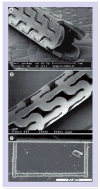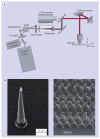Laser direct writing of micro- and nano-scale medical devices
- PMID: 20420557
- PMCID: PMC2916174
- DOI: 10.1586/erd.10.14
Laser direct writing of micro- and nano-scale medical devices
Abstract
Laser-based direct writing of materials has undergone significant development in recent years. The ability to modify a variety of materials at small length scales and using short production times provides laser direct writing with unique capabilities for fabrication of medical devices. In many laser-based rapid prototyping methods, microscale and submicroscale structuring of materials is controlled by computer-generated models. Various laser-based direct write methods, including selective laser sintering/melting, laser machining, matrix-assisted pulsed-laser evaporation direct write, stereolithography and two-photon polymerization, are described. Their use in fabrication of microstructured and nanostructured medical devices is discussed. Laser direct writing may be used for processing a wide variety of advanced medical devices, including patient-specific prostheses, drug delivery devices, biosensors, stents and tissue-engineering scaffolds.
Figures





Similar articles
-
Laser micro machining of medical devices.Med Device Technol. 2009 May-Jun;20(3):29-33. Med Device Technol. 2009. PMID: 19626953
-
Micro- and nanotechnology fabrication processes for metals.Med Device Technol. 2004 Jun;15(5):21-3. Med Device Technol. 2004. PMID: 15285483 Review.
-
Laser Direct Writing of Dual-Scale 3D Structures for Cell Repelling at High Cellular Density.Int J Mol Sci. 2022 Mar 17;23(6):3247. doi: 10.3390/ijms23063247. Int J Mol Sci. 2022. PMID: 35328668 Free PMC article.
-
A Review on Stimuli-Actuated 3D Micro/Nanostructures for Tissue Engineering and the Potential of Laser-Direct Writing via Two-Photon Polymerization for Structure Fabrication.Int J Mol Sci. 2022 Nov 17;23(22):14270. doi: 10.3390/ijms232214270. Int J Mol Sci. 2022. PMID: 36430752 Free PMC article. Review.
-
Rapid Prototyping of Polymeric Nanopillars by 3D Direct Laser Writing for Controlling Cell Behavior.Sci Rep. 2017 Aug 23;7(1):9247. doi: 10.1038/s41598-017-09208-y. Sci Rep. 2017. PMID: 28835653 Free PMC article.
Cited by
-
Biomimetic Designer Scaffolds Made of D,L-Lactide-ɛ-Caprolactone Polymers by 2-Photon Polymerization.Tissue Eng Part B Rev. 2019 Jun;25(3):167-186. doi: 10.1089/ten.TEB.2018.0284. Epub 2019 May 2. Tissue Eng Part B Rev. 2019. PMID: 30632460 Free PMC article. Review.
-
Stereolithography in tissue engineering.J Mater Sci Mater Med. 2014 Mar;25(3):845-56. doi: 10.1007/s10856-013-5107-y. Epub 2013 Dec 4. J Mater Sci Mater Med. 2014. PMID: 24306145 Review.
-
In-vitro perforation of the round window membrane via direct 3-D printed microneedles.Biomed Microdevices. 2018 Jun 8;20(2):47. doi: 10.1007/s10544-018-0287-3. Biomed Microdevices. 2018. PMID: 29884927 Free PMC article.
-
Correlation between properties and microstructure of laser sintered porous β-tricalcium phosphate bone scaffolds.Sci Technol Adv Mater. 2013 Sep 10;14(5):055002. doi: 10.1088/1468-6996/14/5/055002. eCollection 2013 Oct. Sci Technol Adv Mater. 2013. PMID: 27877609 Free PMC article.
-
Fundamentals of Laser-Based Hydrogel Degradation and Applications in Cell and Tissue Engineering.Adv Healthc Mater. 2017 Dec;6(24):10.1002/adhm.201700681. doi: 10.1002/adhm.201700681. Epub 2017 Oct 24. Adv Healthc Mater. 2017. PMID: 29065249 Free PMC article. Review.
References
-
- Ke K, Hasselbrink EF, Hunt AJ. Rapidly prototyped three-dimensional nanofluidic channel networks in glass substrates. Anal Chem. 2005;77(16):5083–5088. - PubMed
-
- Kim TN, Campbell K, Groisman A, Kleinfeld D, Schaffer CB. Femtosecond laser-drilled capillary integrated into a microfluidic device. Appl Phys Lett. 2005;86(20):201106.
-
- Harris ML, Doraiswamy A, Narayan RJ, Patz TM, Chrisey DB. Recent progress in CAD/CAM laser direct-writing of biomaterials. Mater Sci Eng C. 2008;28(3):359–365.
-
Recent report of the progress of matrix-assisted pulsed-laser evaporation direct write technology.
-
- Lee JW, Nguyen TA, Kang KS, Seol Y, Cho D. Development of a growth factor-embedded scaffold with controllable pore size and distribution using micro-stereolithography. Tissue Eng A. 2008;14(5):835.
-
- Lee KB, Solanki A, Kim JD, Jung J. Nanomedicine: dynamic integration of nanotechnology with biomaterials science. In: Zhang M, Xi N, editors. In Nanomedicine: A Systems Engineering Approach. Pan Stanford; Singapore: 2009. pp. 1–38.
Publication types
MeSH terms
Substances
Grants and funding
LinkOut - more resources
Full Text Sources
Other Literature Sources
